SEO Expert for Desklib
VerifiedAdded on 2023/01/07
|19
|3240
|28
AI Summary
Get expert SEO advice for Desklib, an online library for study material with solved assignments, essays, dissertation, etc. Improve your website's visibility and rankings.
Contribute Materials
Your contribution can guide someone’s learning journey. Share your
documents today.
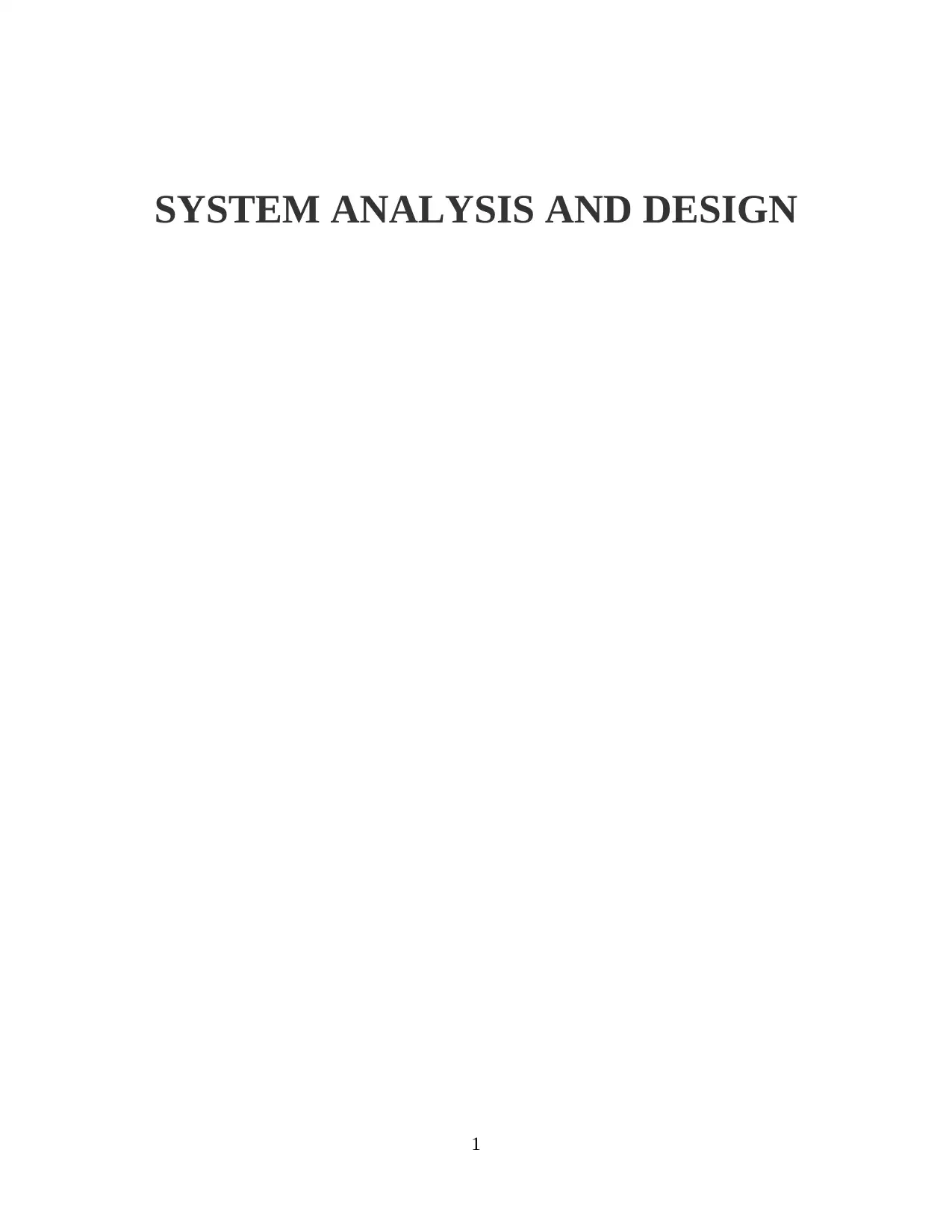
SYSTEM ANALYSIS AND DESIGN
1
1
Secure Best Marks with AI Grader
Need help grading? Try our AI Grader for instant feedback on your assignments.

Contents
INTRODUCTION...........................................................................................................................3
TASK...............................................................................................................................................3
Use Case description for making an appointment, registering accounts.....................................3
Use Case diagram........................................................................................................................6
Identifying all entities and their attribute, create E-R relationship diagram................................7
Class Diagram............................................................................................................................10
Sequence diagram......................................................................................................................11
Activity diagram........................................................................................................................12
Design the data entry screen for enter personal information or data.........................................13
Design booking appointment input screen, which mainly include patient id, name, selected GP
and visit......................................................................................................................................15
Make a suitable testing plan and deployment activities............................................................16
CONCLUSION..............................................................................................................................17
REFERENCES..............................................................................................................................18
2
INTRODUCTION...........................................................................................................................3
TASK...............................................................................................................................................3
Use Case description for making an appointment, registering accounts.....................................3
Use Case diagram........................................................................................................................6
Identifying all entities and their attribute, create E-R relationship diagram................................7
Class Diagram............................................................................................................................10
Sequence diagram......................................................................................................................11
Activity diagram........................................................................................................................12
Design the data entry screen for enter personal information or data.........................................13
Design booking appointment input screen, which mainly include patient id, name, selected GP
and visit......................................................................................................................................15
Make a suitable testing plan and deployment activities............................................................16
CONCLUSION..............................................................................................................................17
REFERENCES..............................................................................................................................18
2
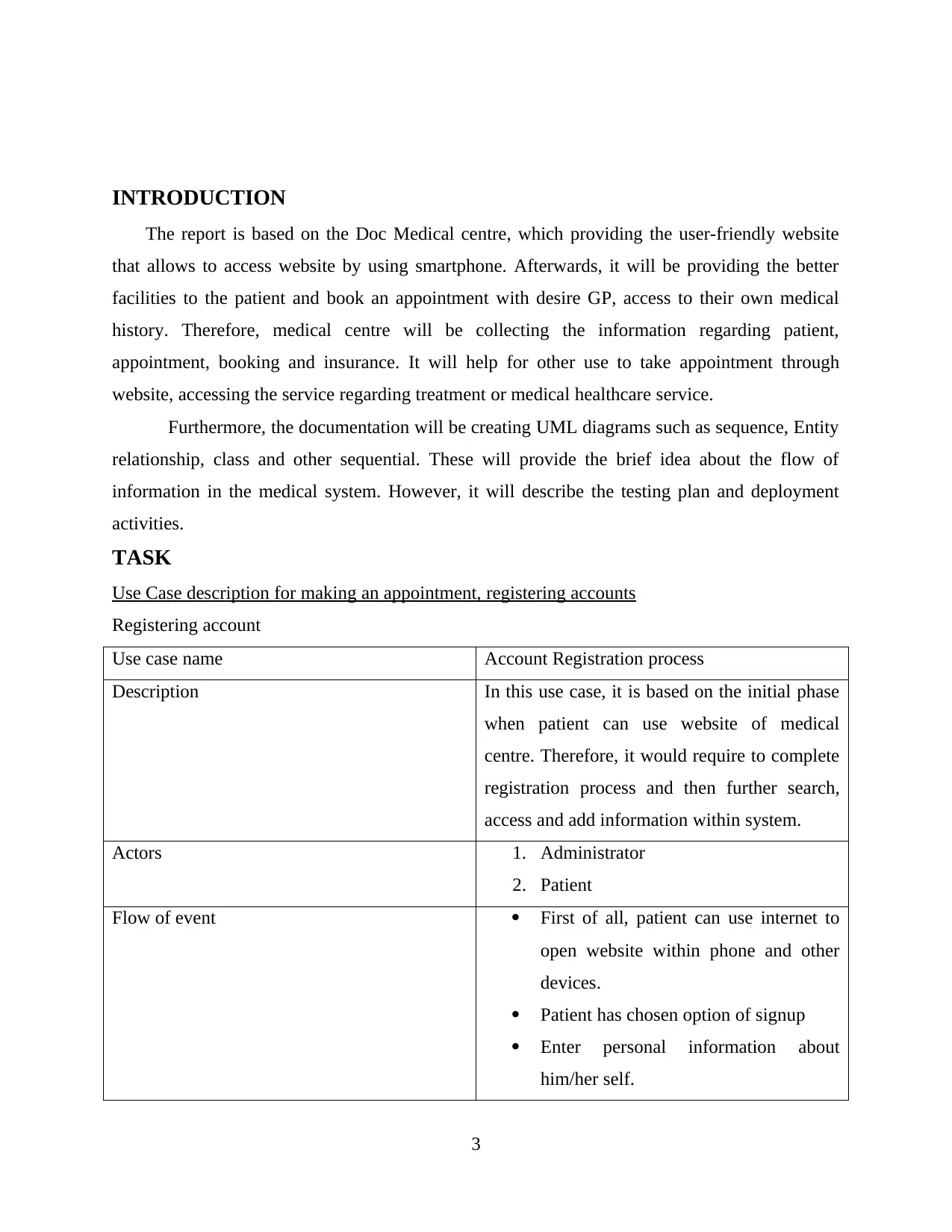
INTRODUCTION
The report is based on the Doc Medical centre, which providing the user-friendly website
that allows to access website by using smartphone. Afterwards, it will be providing the better
facilities to the patient and book an appointment with desire GP, access to their own medical
history. Therefore, medical centre will be collecting the information regarding patient,
appointment, booking and insurance. It will help for other use to take appointment through
website, accessing the service regarding treatment or medical healthcare service.
Furthermore, the documentation will be creating UML diagrams such as sequence, Entity
relationship, class and other sequential. These will provide the brief idea about the flow of
information in the medical system. However, it will describe the testing plan and deployment
activities.
TASK
Use Case description for making an appointment, registering accounts
Registering account
Use case name Account Registration process
Description In this use case, it is based on the initial phase
when patient can use website of medical
centre. Therefore, it would require to complete
registration process and then further search,
access and add information within system.
Actors 1. Administrator
2. Patient
Flow of event First of all, patient can use internet to
open website within phone and other
devices.
Patient has chosen option of signup
Enter personal information about
him/her self.
3
The report is based on the Doc Medical centre, which providing the user-friendly website
that allows to access website by using smartphone. Afterwards, it will be providing the better
facilities to the patient and book an appointment with desire GP, access to their own medical
history. Therefore, medical centre will be collecting the information regarding patient,
appointment, booking and insurance. It will help for other use to take appointment through
website, accessing the service regarding treatment or medical healthcare service.
Furthermore, the documentation will be creating UML diagrams such as sequence, Entity
relationship, class and other sequential. These will provide the brief idea about the flow of
information in the medical system. However, it will describe the testing plan and deployment
activities.
TASK
Use Case description for making an appointment, registering accounts
Registering account
Use case name Account Registration process
Description In this use case, it is based on the initial phase
when patient can use website of medical
centre. Therefore, it would require to complete
registration process and then further search,
access and add information within system.
Actors 1. Administrator
2. Patient
Flow of event First of all, patient can use internet to
open website within phone and other
devices.
Patient has chosen option of signup
Enter personal information about
him/her self.
3
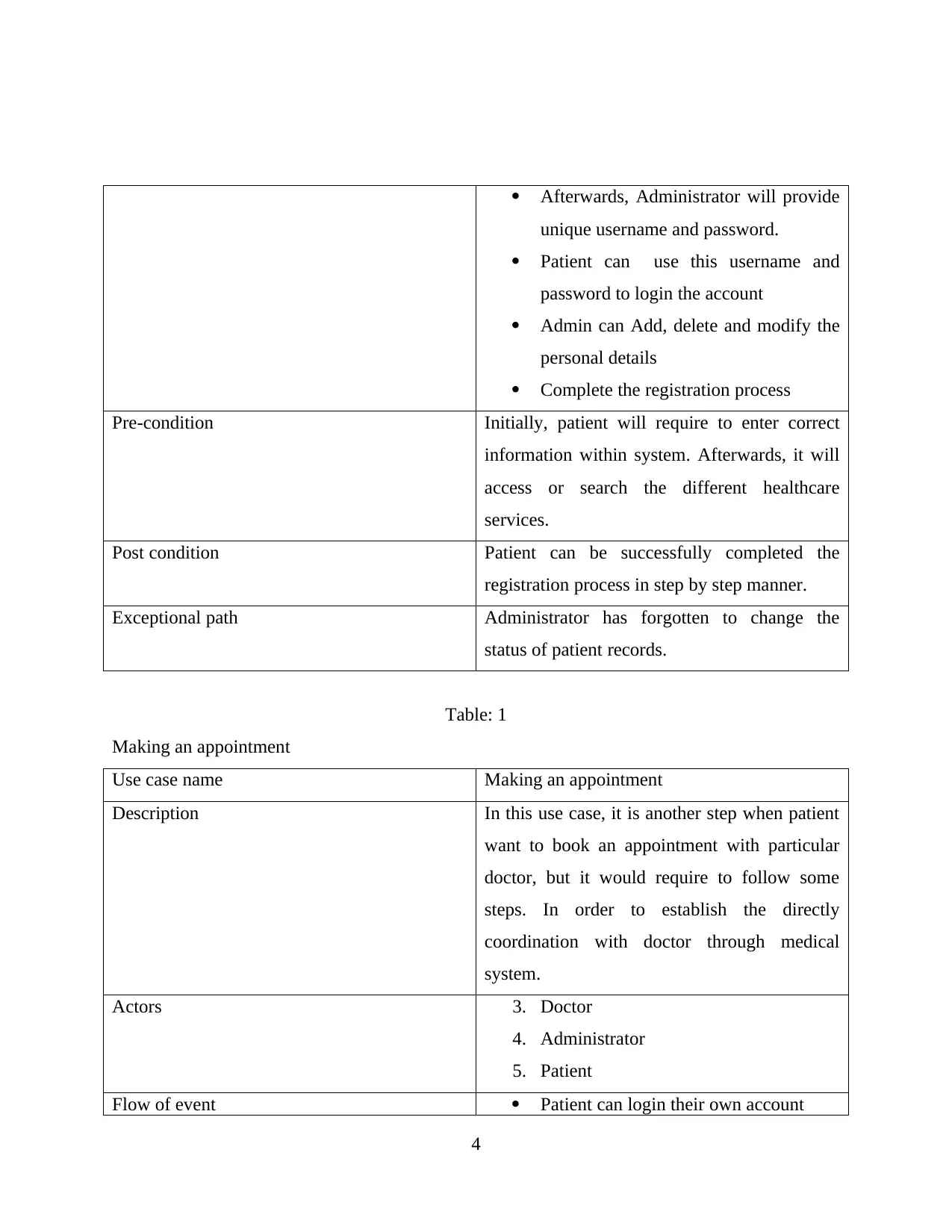
Afterwards, Administrator will provide
unique username and password.
Patient can use this username and
password to login the account
Admin can Add, delete and modify the
personal details
Complete the registration process
Pre-condition Initially, patient will require to enter correct
information within system. Afterwards, it will
access or search the different healthcare
services.
Post condition Patient can be successfully completed the
registration process in step by step manner.
Exceptional path Administrator has forgotten to change the
status of patient records.
Table: 1
Making an appointment
Use case name Making an appointment
Description In this use case, it is another step when patient
want to book an appointment with particular
doctor, but it would require to follow some
steps. In order to establish the directly
coordination with doctor through medical
system.
Actors 3. Doctor
4. Administrator
5. Patient
Flow of event Patient can login their own account
4
unique username and password.
Patient can use this username and
password to login the account
Admin can Add, delete and modify the
personal details
Complete the registration process
Pre-condition Initially, patient will require to enter correct
information within system. Afterwards, it will
access or search the different healthcare
services.
Post condition Patient can be successfully completed the
registration process in step by step manner.
Exceptional path Administrator has forgotten to change the
status of patient records.
Table: 1
Making an appointment
Use case name Making an appointment
Description In this use case, it is another step when patient
want to book an appointment with particular
doctor, but it would require to follow some
steps. In order to establish the directly
coordination with doctor through medical
system.
Actors 3. Doctor
4. Administrator
5. Patient
Flow of event Patient can login their own account
4
Secure Best Marks with AI Grader
Need help grading? Try our AI Grader for instant feedback on your assignments.
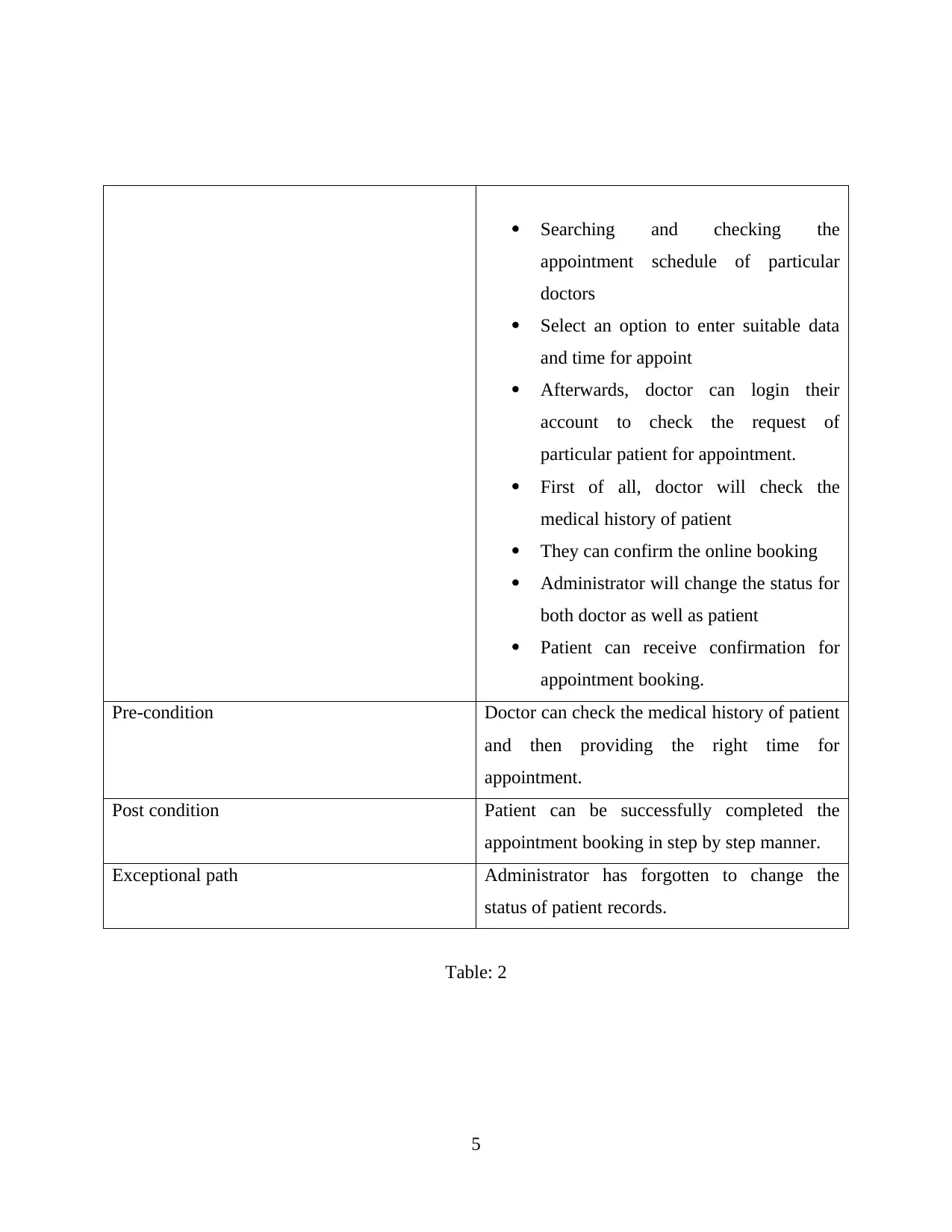
Searching and checking the
appointment schedule of particular
doctors
Select an option to enter suitable data
and time for appoint
Afterwards, doctor can login their
account to check the request of
particular patient for appointment.
First of all, doctor will check the
medical history of patient
They can confirm the online booking
Administrator will change the status for
both doctor as well as patient
Patient can receive confirmation for
appointment booking.
Pre-condition Doctor can check the medical history of patient
and then providing the right time for
appointment.
Post condition Patient can be successfully completed the
appointment booking in step by step manner.
Exceptional path Administrator has forgotten to change the
status of patient records.
Table: 2
5
appointment schedule of particular
doctors
Select an option to enter suitable data
and time for appoint
Afterwards, doctor can login their
account to check the request of
particular patient for appointment.
First of all, doctor will check the
medical history of patient
They can confirm the online booking
Administrator will change the status for
both doctor as well as patient
Patient can receive confirmation for
appointment booking.
Pre-condition Doctor can check the medical history of patient
and then providing the right time for
appointment.
Post condition Patient can be successfully completed the
appointment booking in step by step manner.
Exceptional path Administrator has forgotten to change the
status of patient records.
Table: 2
5
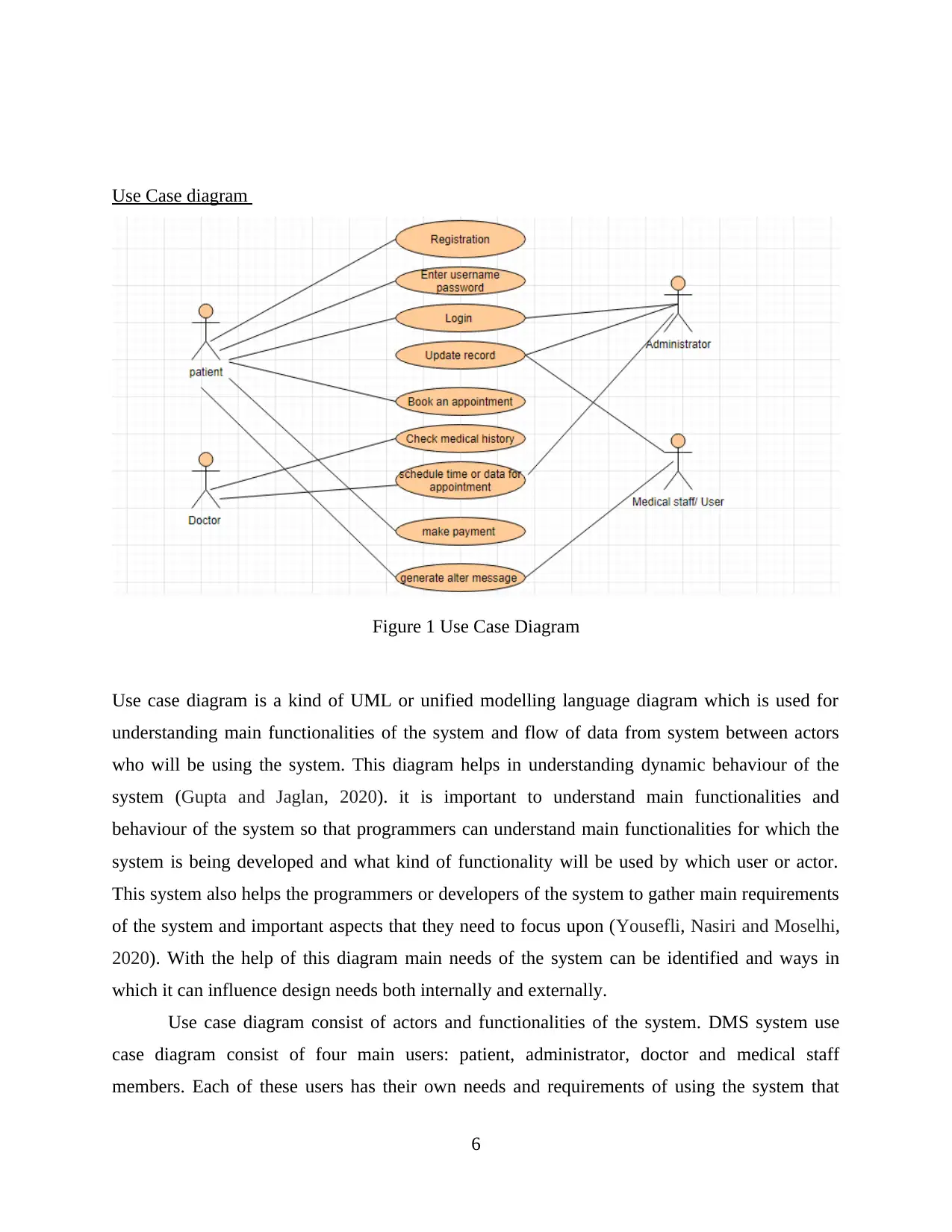
Use Case diagram
Figure 1 Use Case Diagram
Use case diagram is a kind of UML or unified modelling language diagram which is used for
understanding main functionalities of the system and flow of data from system between actors
who will be using the system. This diagram helps in understanding dynamic behaviour of the
system (Gupta and Jaglan, 2020). it is important to understand main functionalities and
behaviour of the system so that programmers can understand main functionalities for which the
system is being developed and what kind of functionality will be used by which user or actor.
This system also helps the programmers or developers of the system to gather main requirements
of the system and important aspects that they need to focus upon (Yousefli, Nasiri and Moselhi,
2020). With the help of this diagram main needs of the system can be identified and ways in
which it can influence design needs both internally and externally.
Use case diagram consist of actors and functionalities of the system. DMS system use
case diagram consist of four main users: patient, administrator, doctor and medical staff
members. Each of these users has their own needs and requirements of using the system that
6
Figure 1 Use Case Diagram
Use case diagram is a kind of UML or unified modelling language diagram which is used for
understanding main functionalities of the system and flow of data from system between actors
who will be using the system. This diagram helps in understanding dynamic behaviour of the
system (Gupta and Jaglan, 2020). it is important to understand main functionalities and
behaviour of the system so that programmers can understand main functionalities for which the
system is being developed and what kind of functionality will be used by which user or actor.
This system also helps the programmers or developers of the system to gather main requirements
of the system and important aspects that they need to focus upon (Yousefli, Nasiri and Moselhi,
2020). With the help of this diagram main needs of the system can be identified and ways in
which it can influence design needs both internally and externally.
Use case diagram consist of actors and functionalities of the system. DMS system use
case diagram consist of four main users: patient, administrator, doctor and medical staff
members. Each of these users has their own needs and requirements of using the system that
6
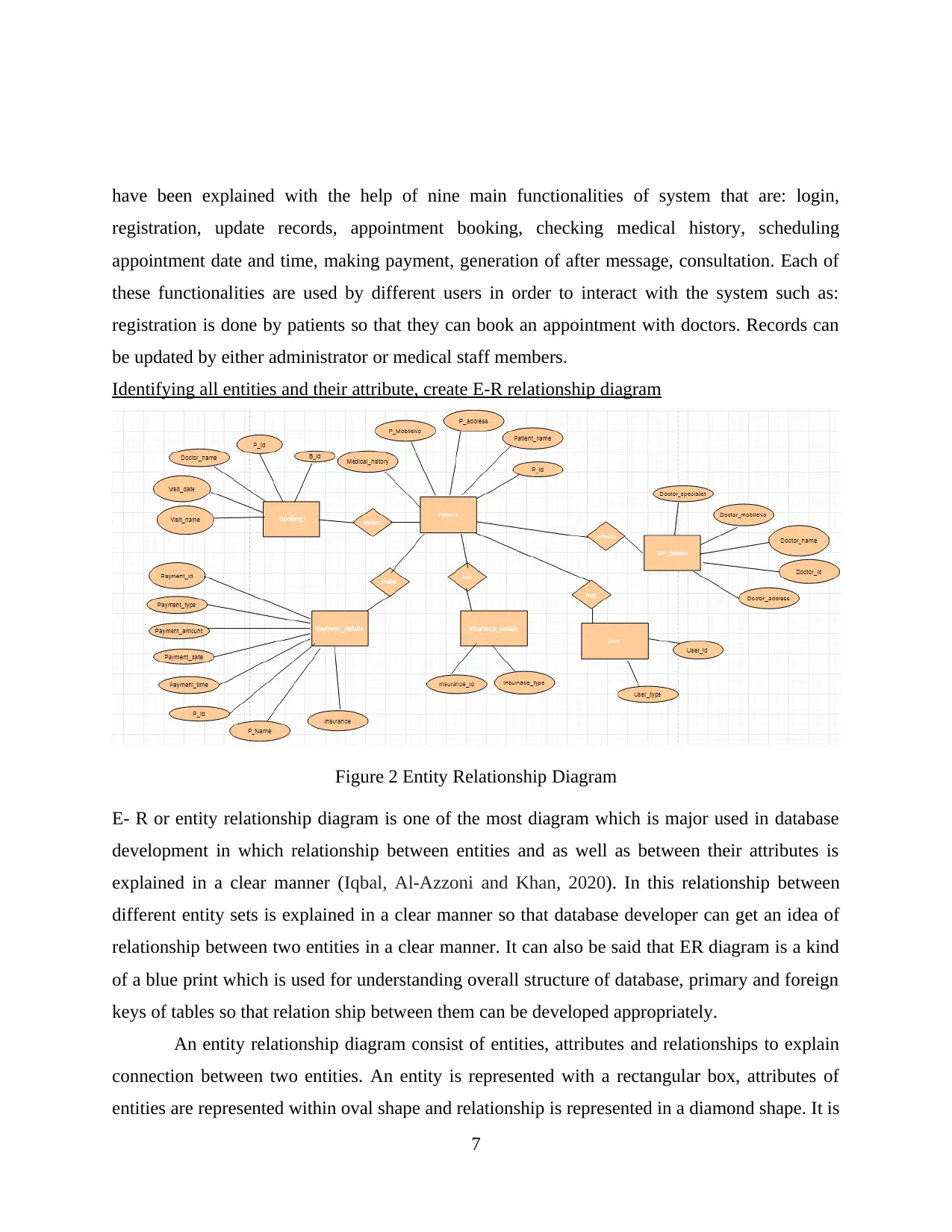
have been explained with the help of nine main functionalities of system that are: login,
registration, update records, appointment booking, checking medical history, scheduling
appointment date and time, making payment, generation of after message, consultation. Each of
these functionalities are used by different users in order to interact with the system such as:
registration is done by patients so that they can book an appointment with doctors. Records can
be updated by either administrator or medical staff members.
Identifying all entities and their attribute, create E-R relationship diagram
Figure 2 Entity Relationship Diagram
E- R or entity relationship diagram is one of the most diagram which is major used in database
development in which relationship between entities and as well as between their attributes is
explained in a clear manner (Iqbal, Al-Azzoni and Khan, 2020). In this relationship between
different entity sets is explained in a clear manner so that database developer can get an idea of
relationship between two entities in a clear manner. It can also be said that ER diagram is a kind
of a blue print which is used for understanding overall structure of database, primary and foreign
keys of tables so that relation ship between them can be developed appropriately.
An entity relationship diagram consist of entities, attributes and relationships to explain
connection between two entities. An entity is represented with a rectangular box, attributes of
entities are represented within oval shape and relationship is represented in a diamond shape. It is
7
registration, update records, appointment booking, checking medical history, scheduling
appointment date and time, making payment, generation of after message, consultation. Each of
these functionalities are used by different users in order to interact with the system such as:
registration is done by patients so that they can book an appointment with doctors. Records can
be updated by either administrator or medical staff members.
Identifying all entities and their attribute, create E-R relationship diagram
Figure 2 Entity Relationship Diagram
E- R or entity relationship diagram is one of the most diagram which is major used in database
development in which relationship between entities and as well as between their attributes is
explained in a clear manner (Iqbal, Al-Azzoni and Khan, 2020). In this relationship between
different entity sets is explained in a clear manner so that database developer can get an idea of
relationship between two entities in a clear manner. It can also be said that ER diagram is a kind
of a blue print which is used for understanding overall structure of database, primary and foreign
keys of tables so that relation ship between them can be developed appropriately.
An entity relationship diagram consist of entities, attributes and relationships to explain
connection between two entities. An entity is represented with a rectangular box, attributes of
entities are represented within oval shape and relationship is represented in a diamond shape. It is
7
Paraphrase This Document
Need a fresh take? Get an instant paraphrase of this document with our AI Paraphraser
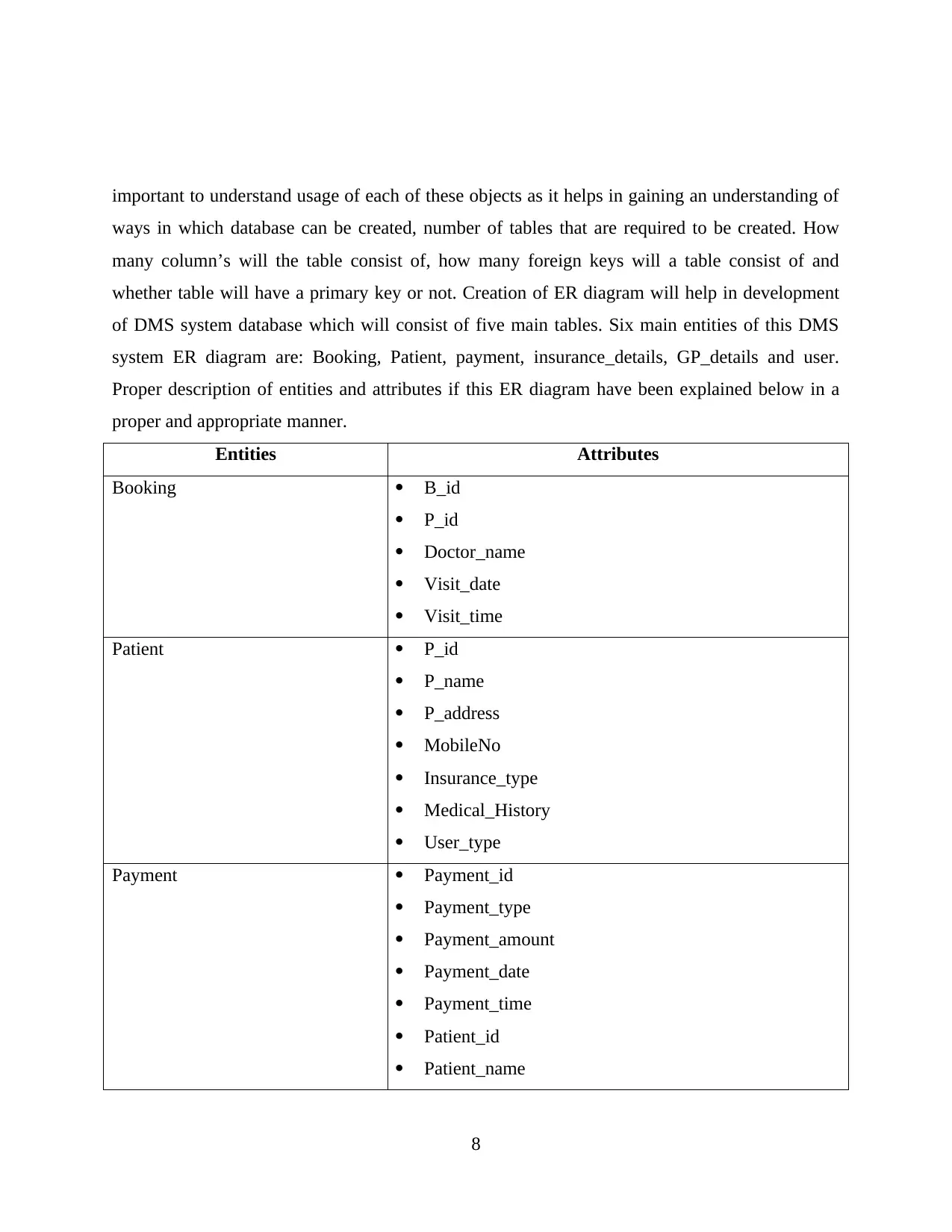
important to understand usage of each of these objects as it helps in gaining an understanding of
ways in which database can be created, number of tables that are required to be created. How
many column’s will the table consist of, how many foreign keys will a table consist of and
whether table will have a primary key or not. Creation of ER diagram will help in development
of DMS system database which will consist of five main tables. Six main entities of this DMS
system ER diagram are: Booking, Patient, payment, insurance_details, GP_details and user.
Proper description of entities and attributes if this ER diagram have been explained below in a
proper and appropriate manner.
Entities Attributes
Booking B_id
P_id
Doctor_name
Visit_date
Visit_time
Patient P_id
P_name
P_address
MobileNo
Insurance_type
Medical_History
User_type
Payment Payment_id
Payment_type
Payment_amount
Payment_date
Payment_time
Patient_id
Patient_name
8
ways in which database can be created, number of tables that are required to be created. How
many column’s will the table consist of, how many foreign keys will a table consist of and
whether table will have a primary key or not. Creation of ER diagram will help in development
of DMS system database which will consist of five main tables. Six main entities of this DMS
system ER diagram are: Booking, Patient, payment, insurance_details, GP_details and user.
Proper description of entities and attributes if this ER diagram have been explained below in a
proper and appropriate manner.
Entities Attributes
Booking B_id
P_id
Doctor_name
Visit_date
Visit_time
Patient P_id
P_name
P_address
MobileNo
Insurance_type
Medical_History
User_type
Payment Payment_id
Payment_type
Payment_amount
Payment_date
Payment_time
Patient_id
Patient_name
8
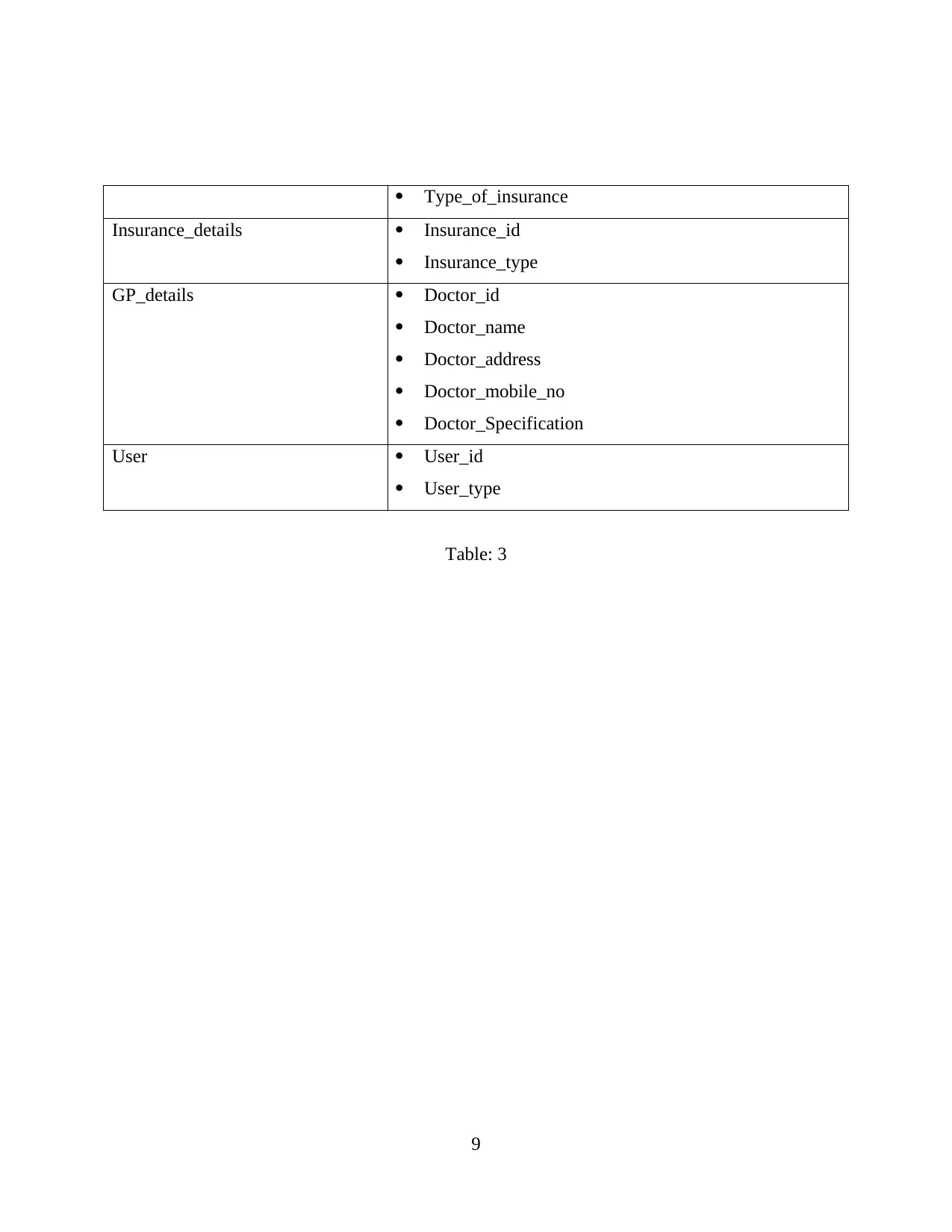
Type_of_insurance
Insurance_details Insurance_id
Insurance_type
GP_details Doctor_id
Doctor_name
Doctor_address
Doctor_mobile_no
Doctor_Specification
User User_id
User_type
Table: 3
9
Insurance_details Insurance_id
Insurance_type
GP_details Doctor_id
Doctor_name
Doctor_address
Doctor_mobile_no
Doctor_Specification
User User_id
User_type
Table: 3
9
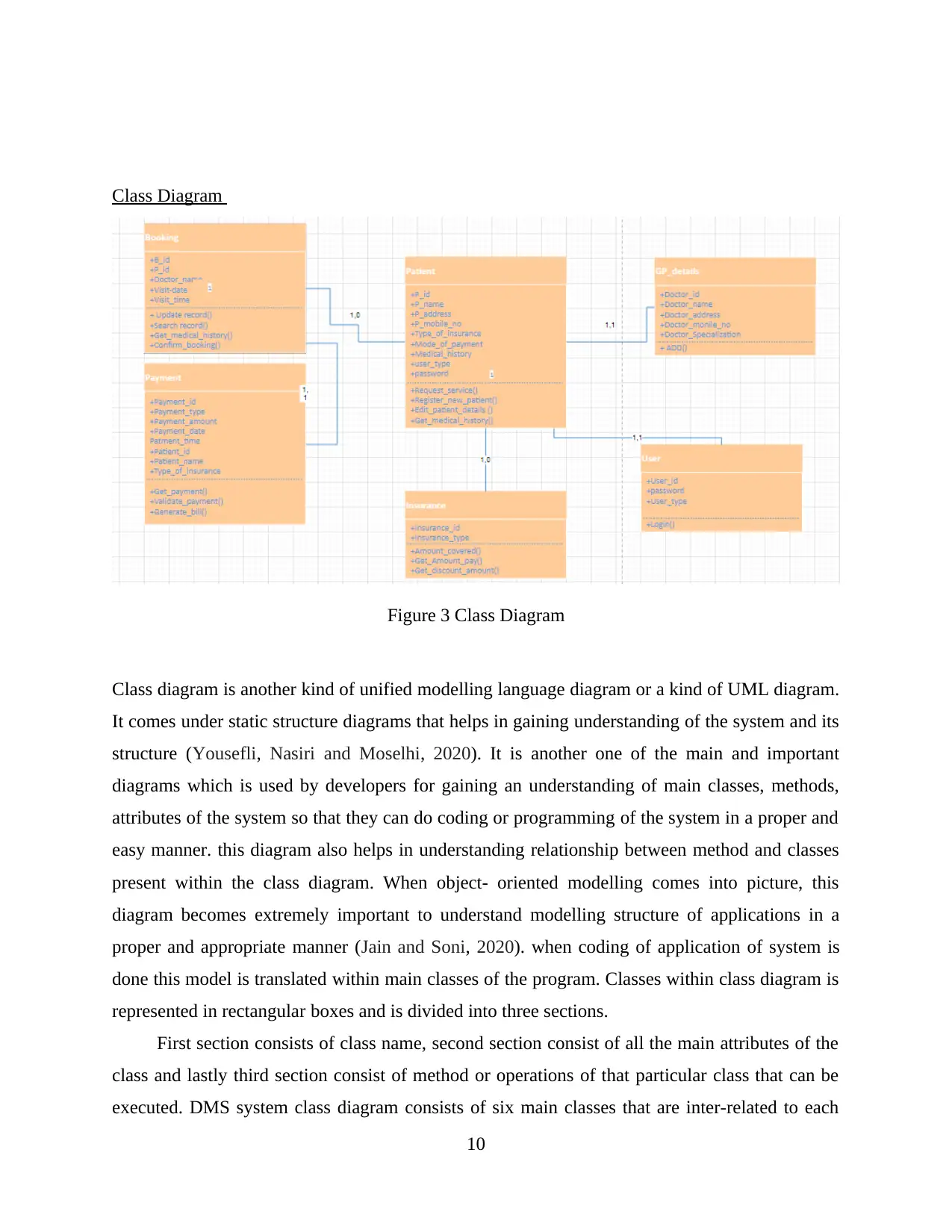
Class Diagram
Figure 3 Class Diagram
Class diagram is another kind of unified modelling language diagram or a kind of UML diagram.
It comes under static structure diagrams that helps in gaining understanding of the system and its
structure (Yousefli, Nasiri and Moselhi, 2020). It is another one of the main and important
diagrams which is used by developers for gaining an understanding of main classes, methods,
attributes of the system so that they can do coding or programming of the system in a proper and
easy manner. this diagram also helps in understanding relationship between method and classes
present within the class diagram. When object- oriented modelling comes into picture, this
diagram becomes extremely important to understand modelling structure of applications in a
proper and appropriate manner (Jain and Soni, 2020). when coding of application of system is
done this model is translated within main classes of the program. Classes within class diagram is
represented in rectangular boxes and is divided into three sections.
First section consists of class name, second section consist of all the main attributes of the
class and lastly third section consist of method or operations of that particular class that can be
executed. DMS system class diagram consists of six main classes that are inter-related to each
10
Figure 3 Class Diagram
Class diagram is another kind of unified modelling language diagram or a kind of UML diagram.
It comes under static structure diagrams that helps in gaining understanding of the system and its
structure (Yousefli, Nasiri and Moselhi, 2020). It is another one of the main and important
diagrams which is used by developers for gaining an understanding of main classes, methods,
attributes of the system so that they can do coding or programming of the system in a proper and
easy manner. this diagram also helps in understanding relationship between method and classes
present within the class diagram. When object- oriented modelling comes into picture, this
diagram becomes extremely important to understand modelling structure of applications in a
proper and appropriate manner (Jain and Soni, 2020). when coding of application of system is
done this model is translated within main classes of the program. Classes within class diagram is
represented in rectangular boxes and is divided into three sections.
First section consists of class name, second section consist of all the main attributes of the
class and lastly third section consist of method or operations of that particular class that can be
executed. DMS system class diagram consists of six main classes that are inter-related to each
10
Secure Best Marks with AI Grader
Need help grading? Try our AI Grader for instant feedback on your assignments.
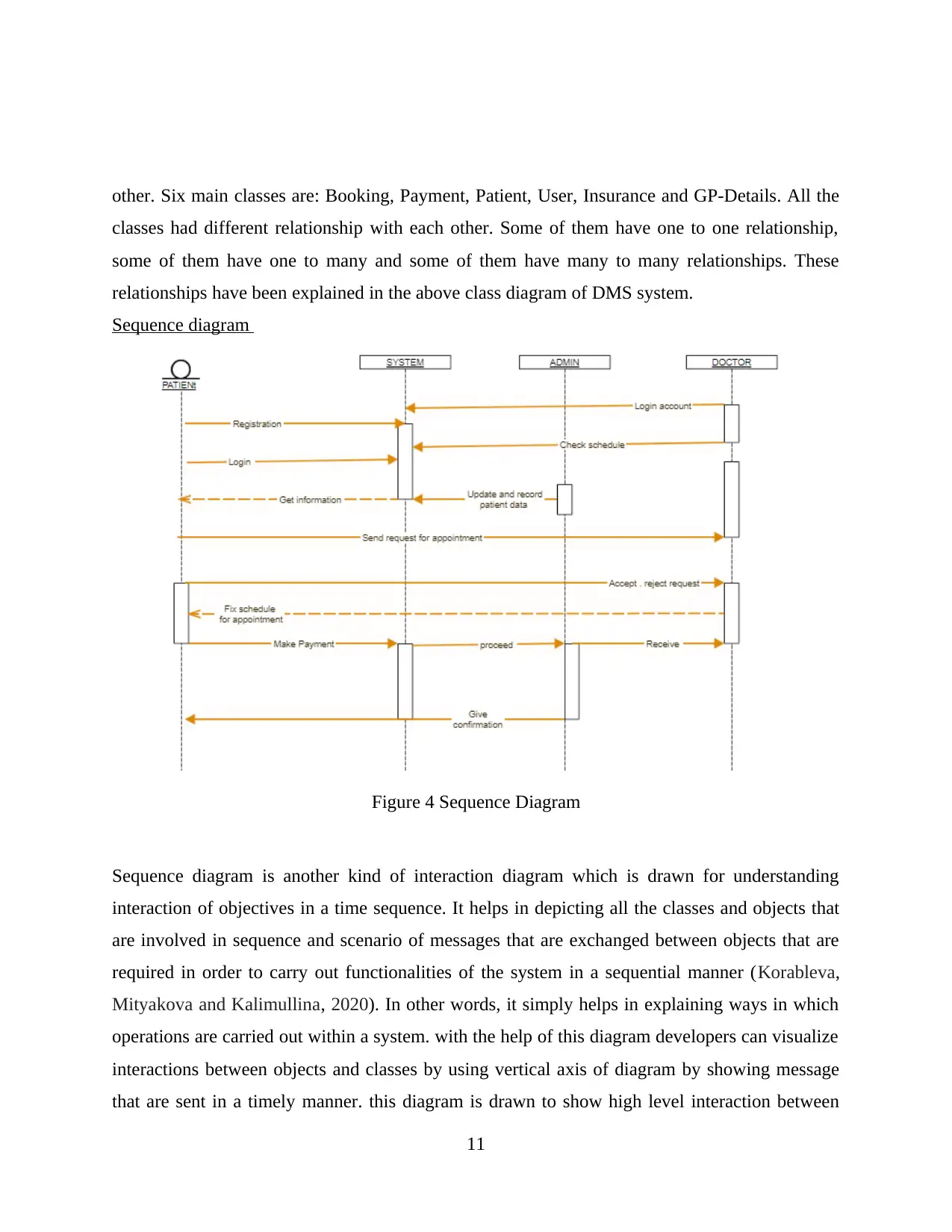
other. Six main classes are: Booking, Payment, Patient, User, Insurance and GP-Details. All the
classes had different relationship with each other. Some of them have one to one relationship,
some of them have one to many and some of them have many to many relationships. These
relationships have been explained in the above class diagram of DMS system.
Sequence diagram
Figure 4 Sequence Diagram
Sequence diagram is another kind of interaction diagram which is drawn for understanding
interaction of objectives in a time sequence. It helps in depicting all the classes and objects that
are involved in sequence and scenario of messages that are exchanged between objects that are
required in order to carry out functionalities of the system in a sequential manner (Korableva,
Mityakova and Kalimullina, 2020). In other words, it simply helps in explaining ways in which
operations are carried out within a system. with the help of this diagram developers can visualize
interactions between objects and classes by using vertical axis of diagram by showing message
that are sent in a timely manner. this diagram is drawn to show high level interaction between
11
classes had different relationship with each other. Some of them have one to one relationship,
some of them have one to many and some of them have many to many relationships. These
relationships have been explained in the above class diagram of DMS system.
Sequence diagram
Figure 4 Sequence Diagram
Sequence diagram is another kind of interaction diagram which is drawn for understanding
interaction of objectives in a time sequence. It helps in depicting all the classes and objects that
are involved in sequence and scenario of messages that are exchanged between objects that are
required in order to carry out functionalities of the system in a sequential manner (Korableva,
Mityakova and Kalimullina, 2020). In other words, it simply helps in explaining ways in which
operations are carried out within a system. with the help of this diagram developers can visualize
interactions between objects and classes by using vertical axis of diagram by showing message
that are sent in a timely manner. this diagram is drawn to show high level interaction between
11
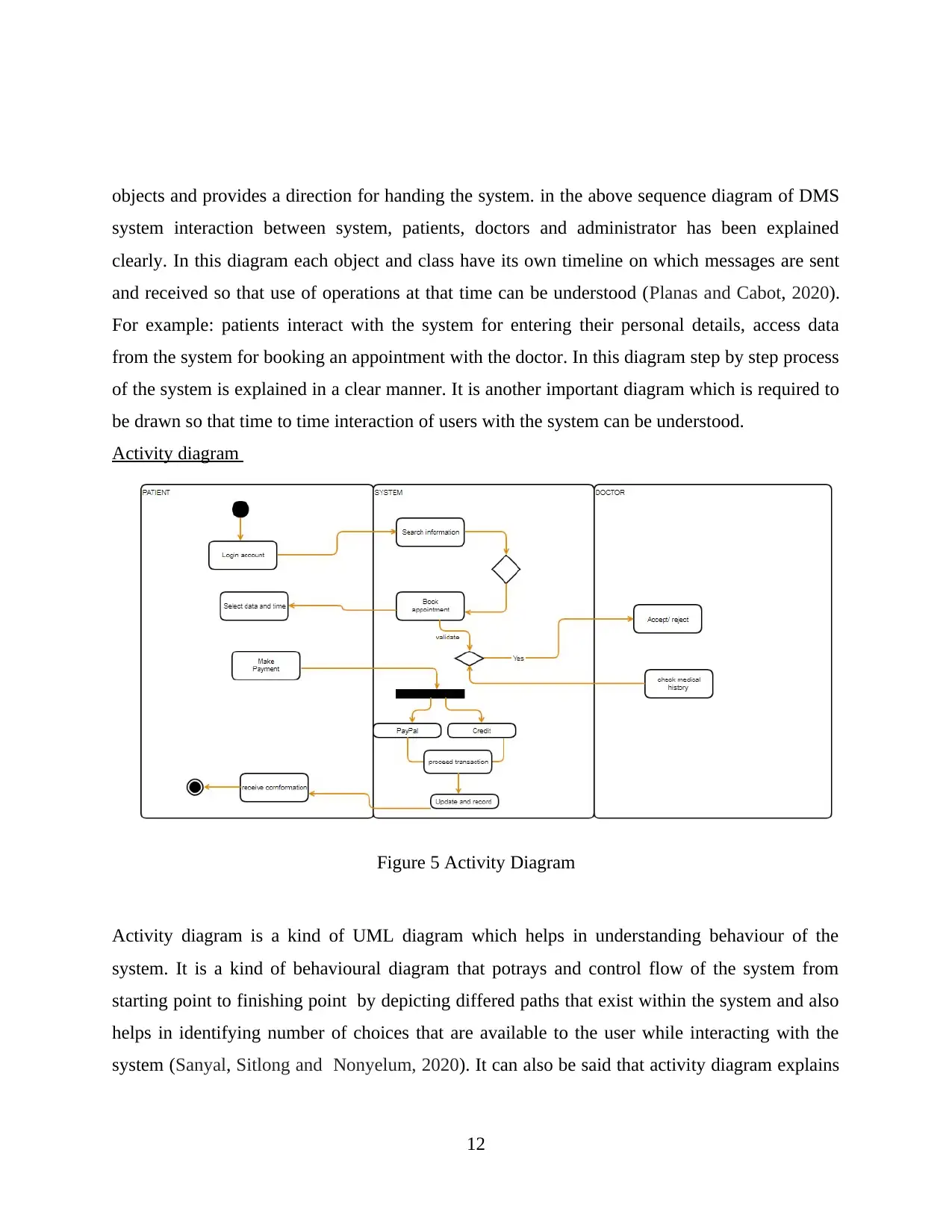
objects and provides a direction for handing the system. in the above sequence diagram of DMS
system interaction between system, patients, doctors and administrator has been explained
clearly. In this diagram each object and class have its own timeline on which messages are sent
and received so that use of operations at that time can be understood (Planas and Cabot, 2020).
For example: patients interact with the system for entering their personal details, access data
from the system for booking an appointment with the doctor. In this diagram step by step process
of the system is explained in a clear manner. It is another important diagram which is required to
be drawn so that time to time interaction of users with the system can be understood.
Activity diagram
Figure 5 Activity Diagram
Activity diagram is a kind of UML diagram which helps in understanding behaviour of the
system. It is a kind of behavioural diagram that potrays and control flow of the system from
starting point to finishing point by depicting differed paths that exist within the system and also
helps in identifying number of choices that are available to the user while interacting with the
system (Sanyal, Sitlong and Nonyelum, 2020). It can also be said that activity diagram explains
12
system interaction between system, patients, doctors and administrator has been explained
clearly. In this diagram each object and class have its own timeline on which messages are sent
and received so that use of operations at that time can be understood (Planas and Cabot, 2020).
For example: patients interact with the system for entering their personal details, access data
from the system for booking an appointment with the doctor. In this diagram step by step process
of the system is explained in a clear manner. It is another important diagram which is required to
be drawn so that time to time interaction of users with the system can be understood.
Activity diagram
Figure 5 Activity Diagram
Activity diagram is a kind of UML diagram which helps in understanding behaviour of the
system. It is a kind of behavioural diagram that potrays and control flow of the system from
starting point to finishing point by depicting differed paths that exist within the system and also
helps in identifying number of choices that are available to the user while interacting with the
system (Sanyal, Sitlong and Nonyelum, 2020). It can also be said that activity diagram explains
12
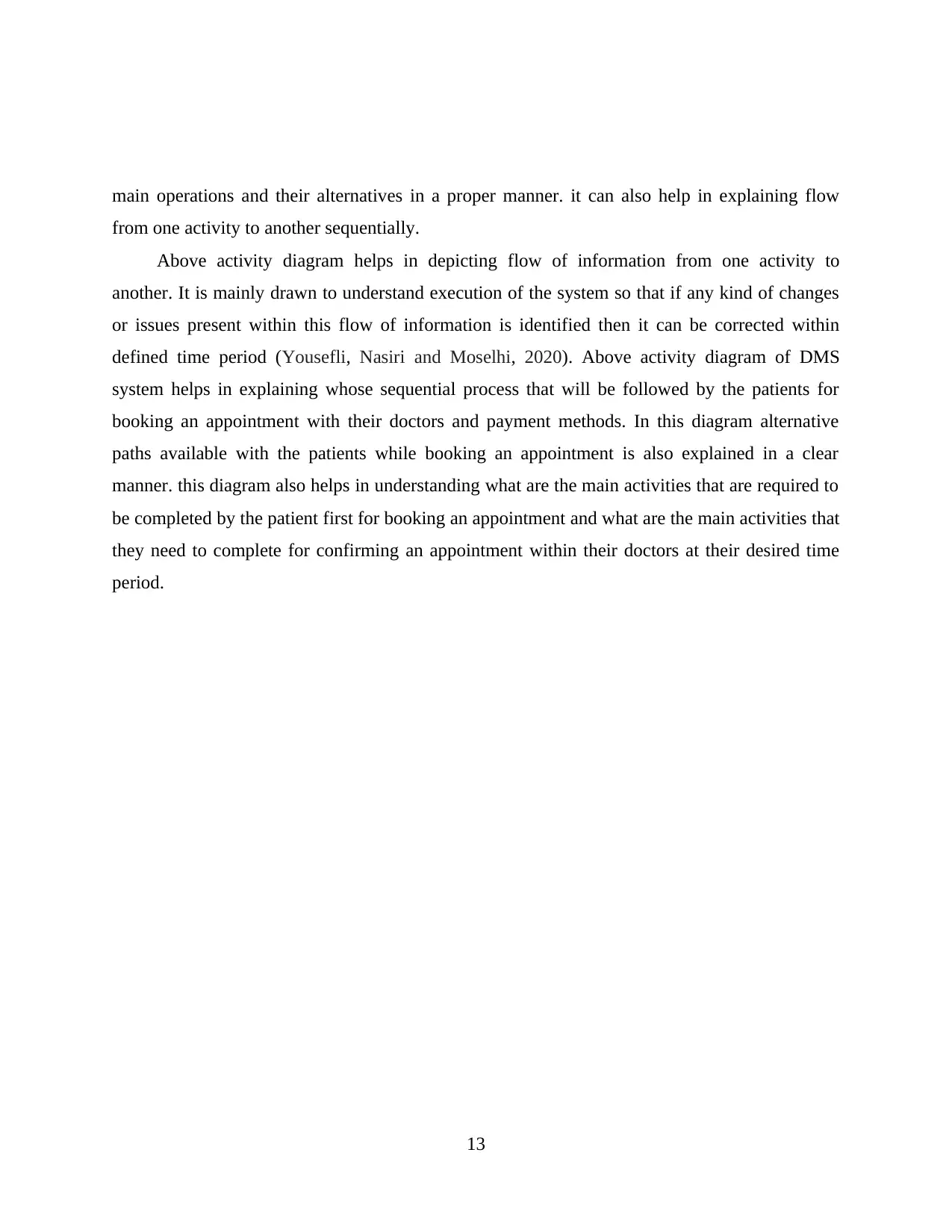
main operations and their alternatives in a proper manner. it can also help in explaining flow
from one activity to another sequentially.
Above activity diagram helps in depicting flow of information from one activity to
another. It is mainly drawn to understand execution of the system so that if any kind of changes
or issues present within this flow of information is identified then it can be corrected within
defined time period (Yousefli, Nasiri and Moselhi, 2020). Above activity diagram of DMS
system helps in explaining whose sequential process that will be followed by the patients for
booking an appointment with their doctors and payment methods. In this diagram alternative
paths available with the patients while booking an appointment is also explained in a clear
manner. this diagram also helps in understanding what are the main activities that are required to
be completed by the patient first for booking an appointment and what are the main activities that
they need to complete for confirming an appointment within their doctors at their desired time
period.
13
from one activity to another sequentially.
Above activity diagram helps in depicting flow of information from one activity to
another. It is mainly drawn to understand execution of the system so that if any kind of changes
or issues present within this flow of information is identified then it can be corrected within
defined time period (Yousefli, Nasiri and Moselhi, 2020). Above activity diagram of DMS
system helps in explaining whose sequential process that will be followed by the patients for
booking an appointment with their doctors and payment methods. In this diagram alternative
paths available with the patients while booking an appointment is also explained in a clear
manner. this diagram also helps in understanding what are the main activities that are required to
be completed by the patient first for booking an appointment and what are the main activities that
they need to complete for confirming an appointment within their doctors at their desired time
period.
13
Paraphrase This Document
Need a fresh take? Get an instant paraphrase of this document with our AI Paraphraser
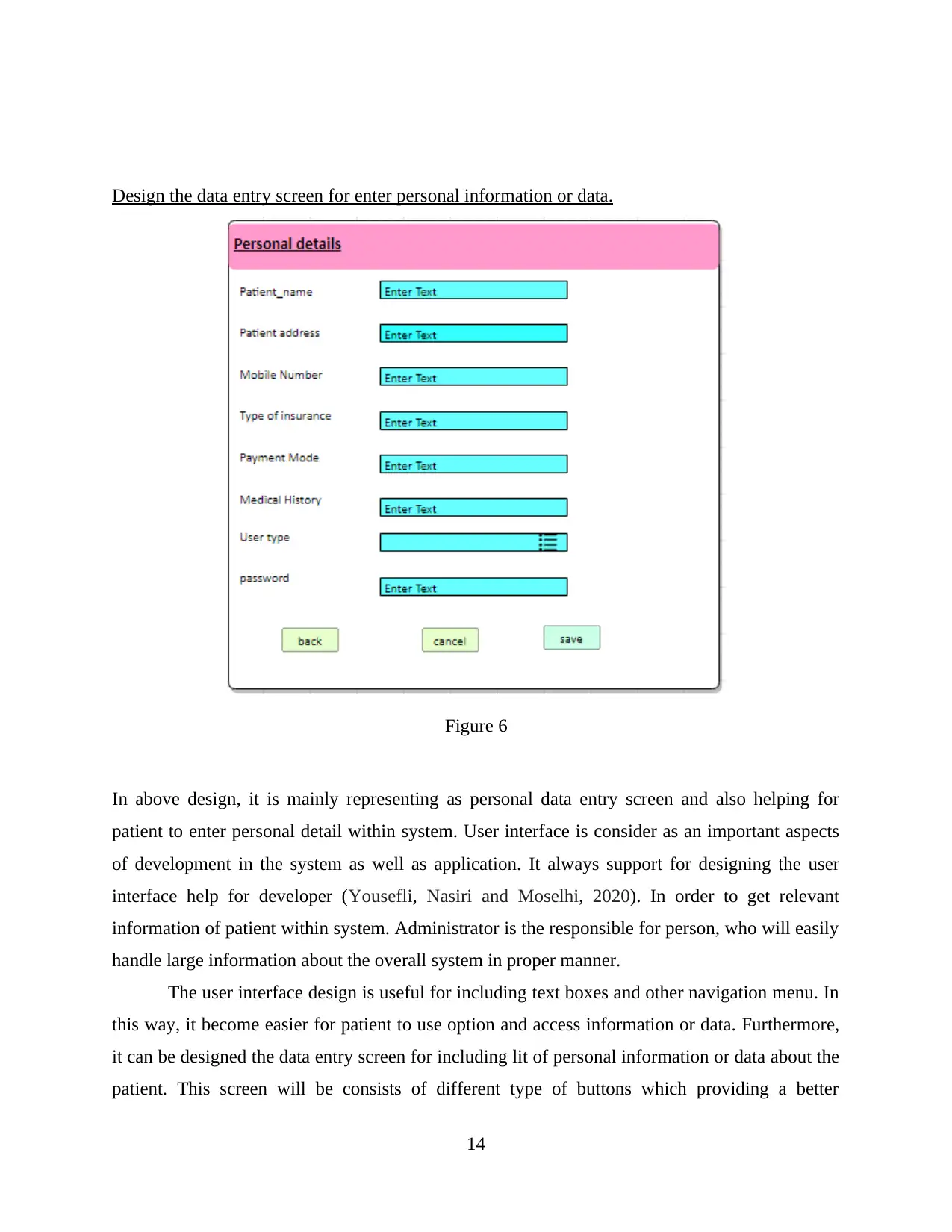
Design the data entry screen for enter personal information or data.
Figure 6
In above design, it is mainly representing as personal data entry screen and also helping for
patient to enter personal detail within system. User interface is consider as an important aspects
of development in the system as well as application. It always support for designing the user
interface help for developer (Yousefli, Nasiri and Moselhi, 2020). In order to get relevant
information of patient within system. Administrator is the responsible for person, who will easily
handle large information about the overall system in proper manner.
The user interface design is useful for including text boxes and other navigation menu. In
this way, it become easier for patient to use option and access information or data. Furthermore,
it can be designed the data entry screen for including lit of personal information or data about the
patient. This screen will be consists of different type of buttons which providing a better
14
Figure 6
In above design, it is mainly representing as personal data entry screen and also helping for
patient to enter personal detail within system. User interface is consider as an important aspects
of development in the system as well as application. It always support for designing the user
interface help for developer (Yousefli, Nasiri and Moselhi, 2020). In order to get relevant
information of patient within system. Administrator is the responsible for person, who will easily
handle large information about the overall system in proper manner.
The user interface design is useful for including text boxes and other navigation menu. In
this way, it become easier for patient to use option and access information or data. Furthermore,
it can be designed the data entry screen for including lit of personal information or data about the
patient. This screen will be consists of different type of buttons which providing a better
14
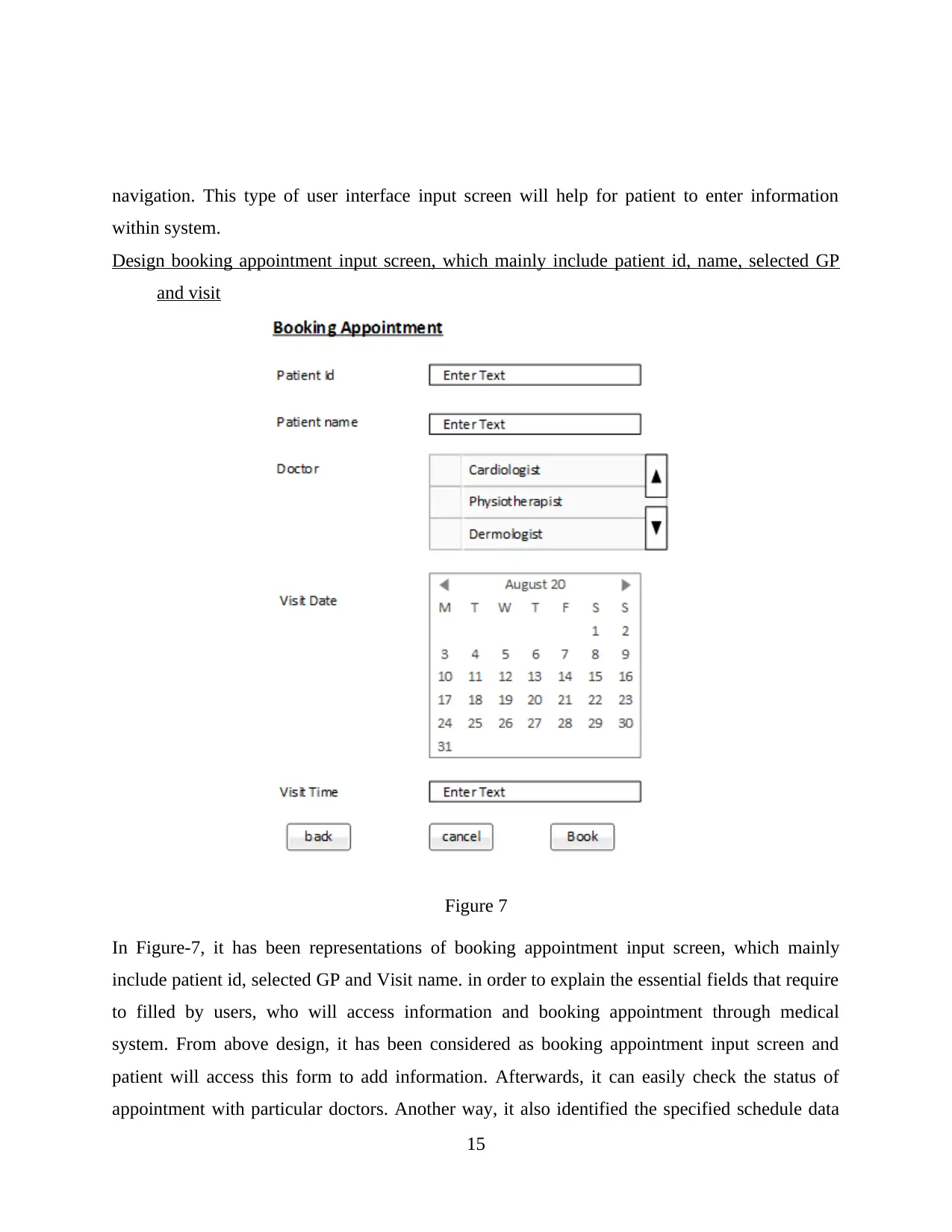
navigation. This type of user interface input screen will help for patient to enter information
within system.
Design booking appointment input screen, which mainly include patient id, name, selected GP
and visit
Figure 7
In Figure-7, it has been representations of booking appointment input screen, which mainly
include patient id, selected GP and Visit name. in order to explain the essential fields that require
to filled by users, who will access information and booking appointment through medical
system. From above design, it has been considered as booking appointment input screen and
patient will access this form to add information. Afterwards, it can easily check the status of
appointment with particular doctors. Another way, it also identified the specified schedule data
15
within system.
Design booking appointment input screen, which mainly include patient id, name, selected GP
and visit
Figure 7
In Figure-7, it has been representations of booking appointment input screen, which mainly
include patient id, selected GP and Visit name. in order to explain the essential fields that require
to filled by users, who will access information and booking appointment through medical
system. From above design, it has been considered as booking appointment input screen and
patient will access this form to add information. Afterwards, it can easily check the status of
appointment with particular doctors. Another way, it also identified the specified schedule data
15
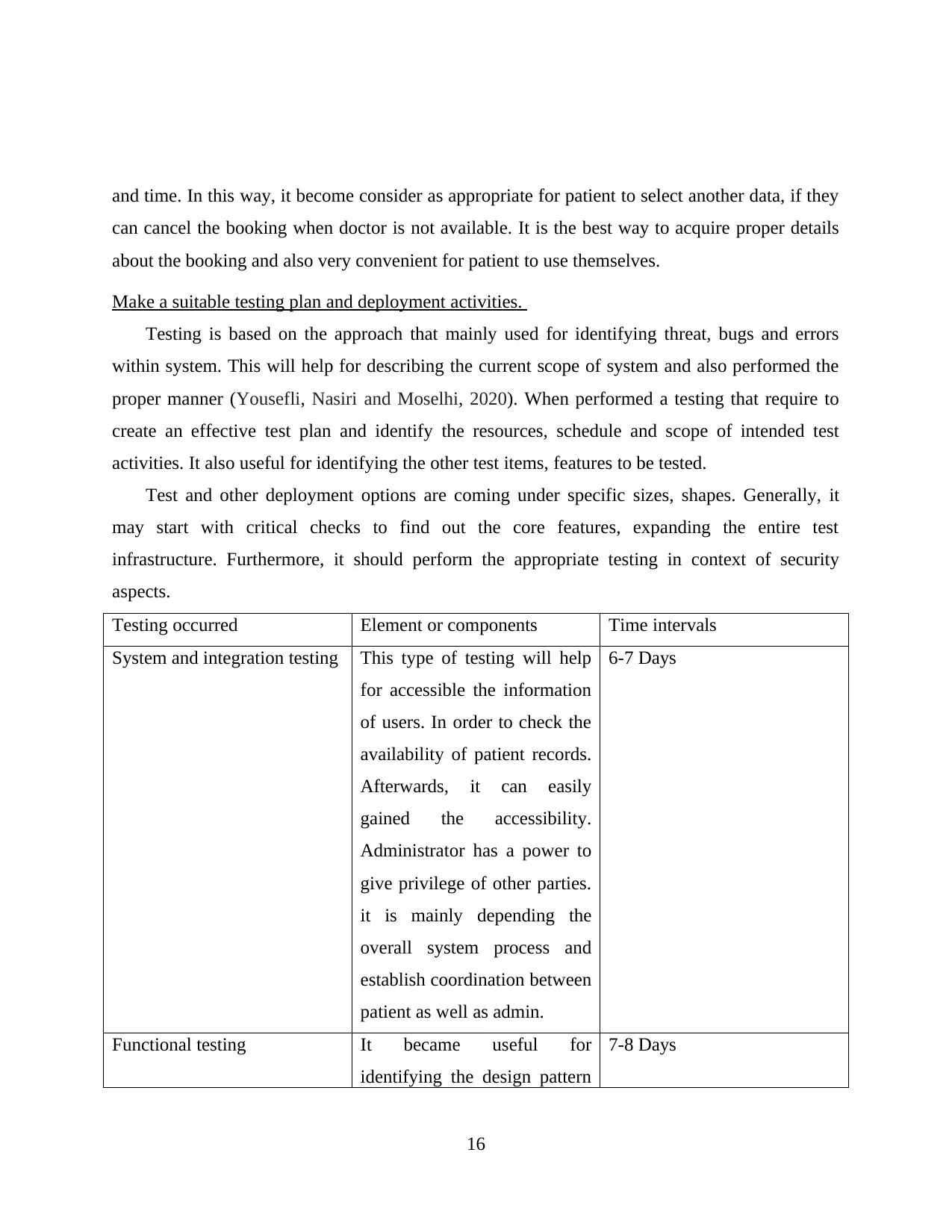
and time. In this way, it become consider as appropriate for patient to select another data, if they
can cancel the booking when doctor is not available. It is the best way to acquire proper details
about the booking and also very convenient for patient to use themselves.
Make a suitable testing plan and deployment activities.
Testing is based on the approach that mainly used for identifying threat, bugs and errors
within system. This will help for describing the current scope of system and also performed the
proper manner (Yousefli, Nasiri and Moselhi, 2020). When performed a testing that require to
create an effective test plan and identify the resources, schedule and scope of intended test
activities. It also useful for identifying the other test items, features to be tested.
Test and other deployment options are coming under specific sizes, shapes. Generally, it
may start with critical checks to find out the core features, expanding the entire test
infrastructure. Furthermore, it should perform the appropriate testing in context of security
aspects.
Testing occurred Element or components Time intervals
System and integration testing This type of testing will help
for accessible the information
of users. In order to check the
availability of patient records.
Afterwards, it can easily
gained the accessibility.
Administrator has a power to
give privilege of other parties.
it is mainly depending the
overall system process and
establish coordination between
patient as well as admin.
6-7 Days
Functional testing It became useful for
identifying the design pattern
7-8 Days
16
can cancel the booking when doctor is not available. It is the best way to acquire proper details
about the booking and also very convenient for patient to use themselves.
Make a suitable testing plan and deployment activities.
Testing is based on the approach that mainly used for identifying threat, bugs and errors
within system. This will help for describing the current scope of system and also performed the
proper manner (Yousefli, Nasiri and Moselhi, 2020). When performed a testing that require to
create an effective test plan and identify the resources, schedule and scope of intended test
activities. It also useful for identifying the other test items, features to be tested.
Test and other deployment options are coming under specific sizes, shapes. Generally, it
may start with critical checks to find out the core features, expanding the entire test
infrastructure. Furthermore, it should perform the appropriate testing in context of security
aspects.
Testing occurred Element or components Time intervals
System and integration testing This type of testing will help
for accessible the information
of users. In order to check the
availability of patient records.
Afterwards, it can easily
gained the accessibility.
Administrator has a power to
give privilege of other parties.
it is mainly depending the
overall system process and
establish coordination between
patient as well as admin.
6-7 Days
Functional testing It became useful for
identifying the design pattern
7-8 Days
16
Secure Best Marks with AI Grader
Need help grading? Try our AI Grader for instant feedback on your assignments.
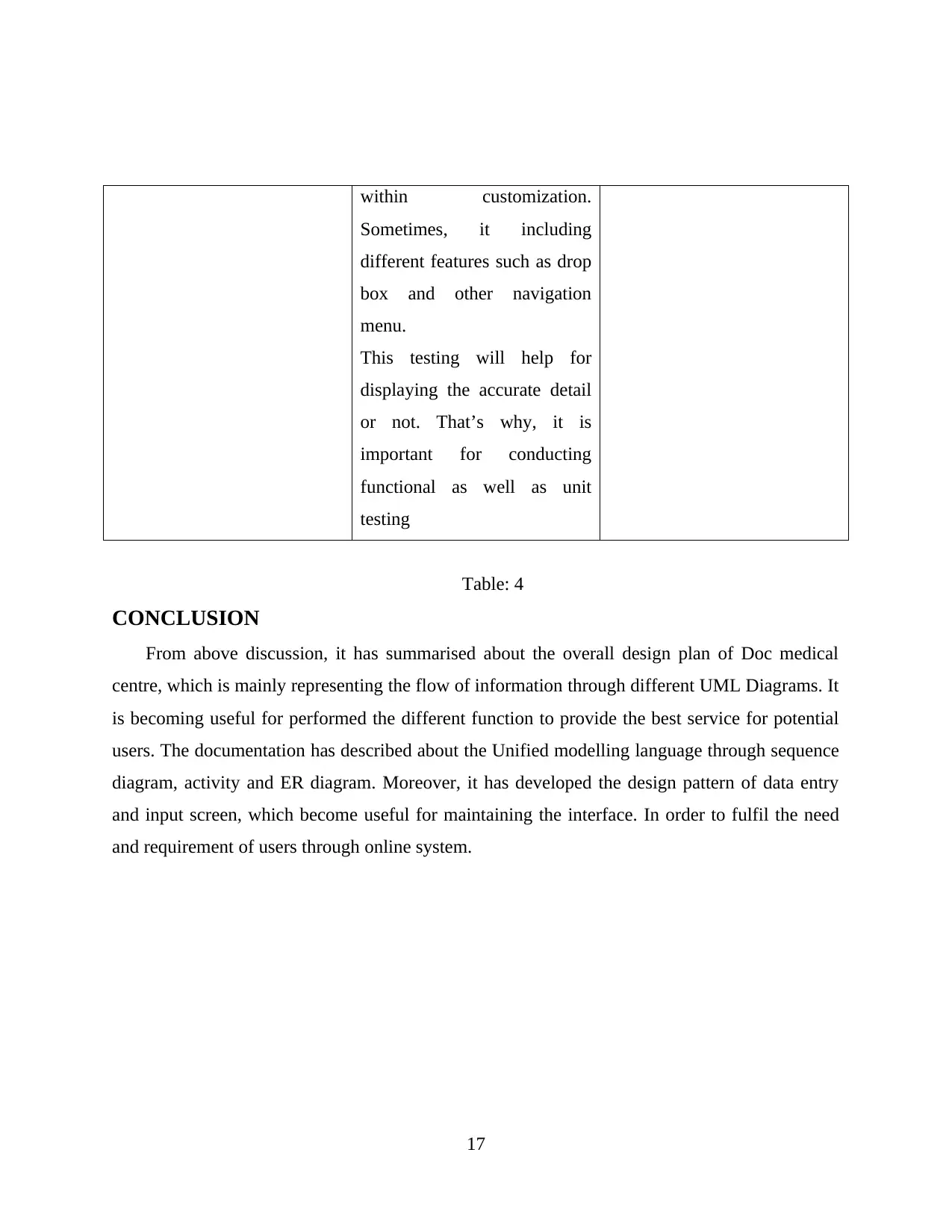
within customization.
Sometimes, it including
different features such as drop
box and other navigation
menu.
This testing will help for
displaying the accurate detail
or not. That’s why, it is
important for conducting
functional as well as unit
testing
Table: 4
CONCLUSION
From above discussion, it has summarised about the overall design plan of Doc medical
centre, which is mainly representing the flow of information through different UML Diagrams. It
is becoming useful for performed the different function to provide the best service for potential
users. The documentation has described about the Unified modelling language through sequence
diagram, activity and ER diagram. Moreover, it has developed the design pattern of data entry
and input screen, which become useful for maintaining the interface. In order to fulfil the need
and requirement of users through online system.
17
Sometimes, it including
different features such as drop
box and other navigation
menu.
This testing will help for
displaying the accurate detail
or not. That’s why, it is
important for conducting
functional as well as unit
testing
Table: 4
CONCLUSION
From above discussion, it has summarised about the overall design plan of Doc medical
centre, which is mainly representing the flow of information through different UML Diagrams. It
is becoming useful for performed the different function to provide the best service for potential
users. The documentation has described about the Unified modelling language through sequence
diagram, activity and ER diagram. Moreover, it has developed the design pattern of data entry
and input screen, which become useful for maintaining the interface. In order to fulfil the need
and requirement of users through online system.
17
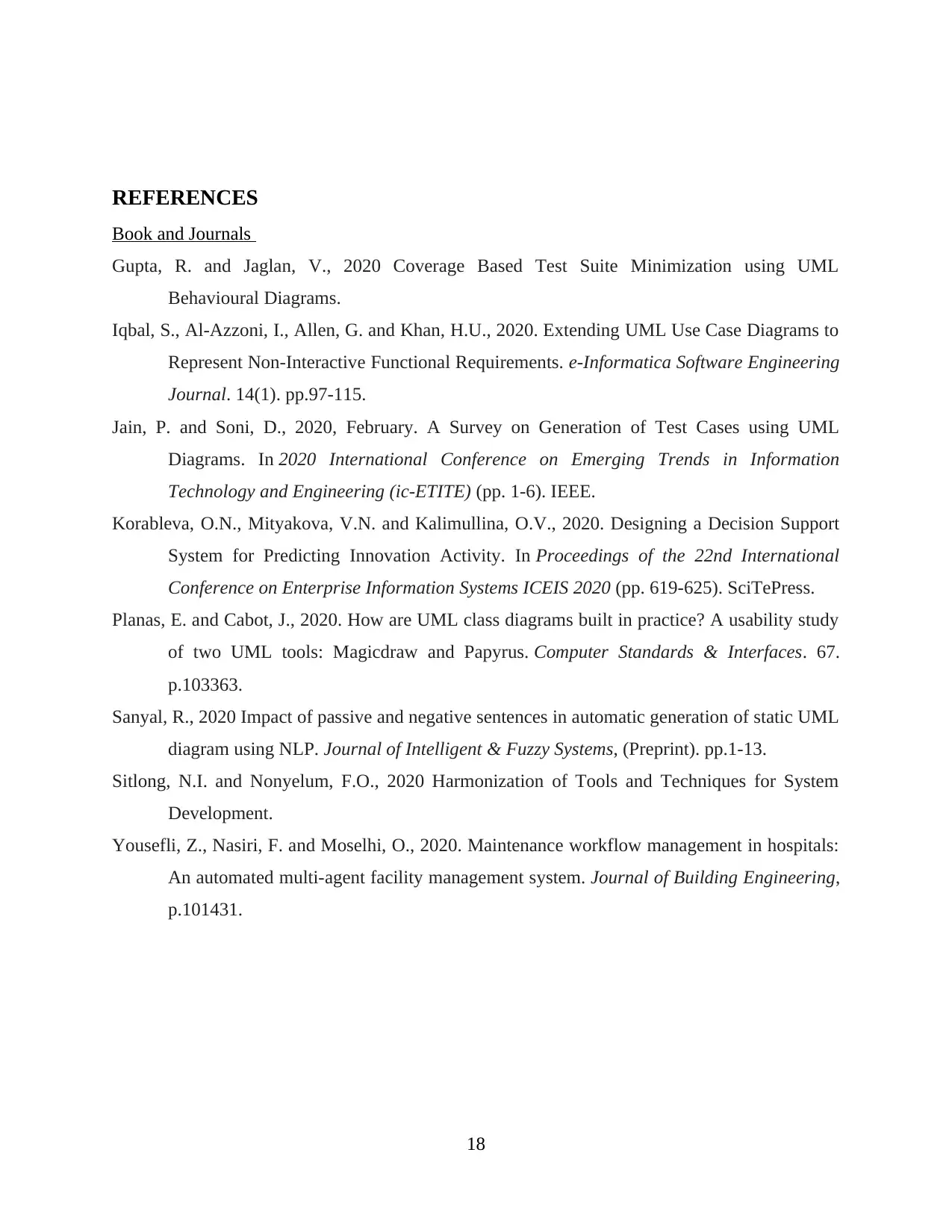
REFERENCES
Book and Journals
Gupta, R. and Jaglan, V., 2020 Coverage Based Test Suite Minimization using UML
Behavioural Diagrams.
Iqbal, S., Al-Azzoni, I., Allen, G. and Khan, H.U., 2020. Extending UML Use Case Diagrams to
Represent Non-Interactive Functional Requirements. e-Informatica Software Engineering
Journal. 14(1). pp.97-115.
Jain, P. and Soni, D., 2020, February. A Survey on Generation of Test Cases using UML
Diagrams. In 2020 International Conference on Emerging Trends in Information
Technology and Engineering (ic-ETITE) (pp. 1-6). IEEE.
Korableva, O.N., Mityakova, V.N. and Kalimullina, O.V., 2020. Designing a Decision Support
System for Predicting Innovation Activity. In Proceedings of the 22nd International
Conference on Enterprise Information Systems ICEIS 2020 (pp. 619-625). SciTePress.
Planas, E. and Cabot, J., 2020. How are UML class diagrams built in practice? A usability study
of two UML tools: Magicdraw and Papyrus. Computer Standards & Interfaces. 67.
p.103363.
Sanyal, R., 2020 Impact of passive and negative sentences in automatic generation of static UML
diagram using NLP. Journal of Intelligent & Fuzzy Systems, (Preprint). pp.1-13.
Sitlong, N.I. and Nonyelum, F.O., 2020 Harmonization of Tools and Techniques for System
Development.
Yousefli, Z., Nasiri, F. and Moselhi, O., 2020. Maintenance workflow management in hospitals:
An automated multi-agent facility management system. Journal of Building Engineering,
p.101431.
18
Book and Journals
Gupta, R. and Jaglan, V., 2020 Coverage Based Test Suite Minimization using UML
Behavioural Diagrams.
Iqbal, S., Al-Azzoni, I., Allen, G. and Khan, H.U., 2020. Extending UML Use Case Diagrams to
Represent Non-Interactive Functional Requirements. e-Informatica Software Engineering
Journal. 14(1). pp.97-115.
Jain, P. and Soni, D., 2020, February. A Survey on Generation of Test Cases using UML
Diagrams. In 2020 International Conference on Emerging Trends in Information
Technology and Engineering (ic-ETITE) (pp. 1-6). IEEE.
Korableva, O.N., Mityakova, V.N. and Kalimullina, O.V., 2020. Designing a Decision Support
System for Predicting Innovation Activity. In Proceedings of the 22nd International
Conference on Enterprise Information Systems ICEIS 2020 (pp. 619-625). SciTePress.
Planas, E. and Cabot, J., 2020. How are UML class diagrams built in practice? A usability study
of two UML tools: Magicdraw and Papyrus. Computer Standards & Interfaces. 67.
p.103363.
Sanyal, R., 2020 Impact of passive and negative sentences in automatic generation of static UML
diagram using NLP. Journal of Intelligent & Fuzzy Systems, (Preprint). pp.1-13.
Sitlong, N.I. and Nonyelum, F.O., 2020 Harmonization of Tools and Techniques for System
Development.
Yousefli, Z., Nasiri, F. and Moselhi, O., 2020. Maintenance workflow management in hospitals:
An automated multi-agent facility management system. Journal of Building Engineering,
p.101431.
18

19
1 out of 19
Related Documents
Your All-in-One AI-Powered Toolkit for Academic Success.
+13062052269
info@desklib.com
Available 24*7 on WhatsApp / Email
![[object Object]](/_next/static/media/star-bottom.7253800d.svg)
Unlock your academic potential
© 2024 | Zucol Services PVT LTD | All rights reserved.





